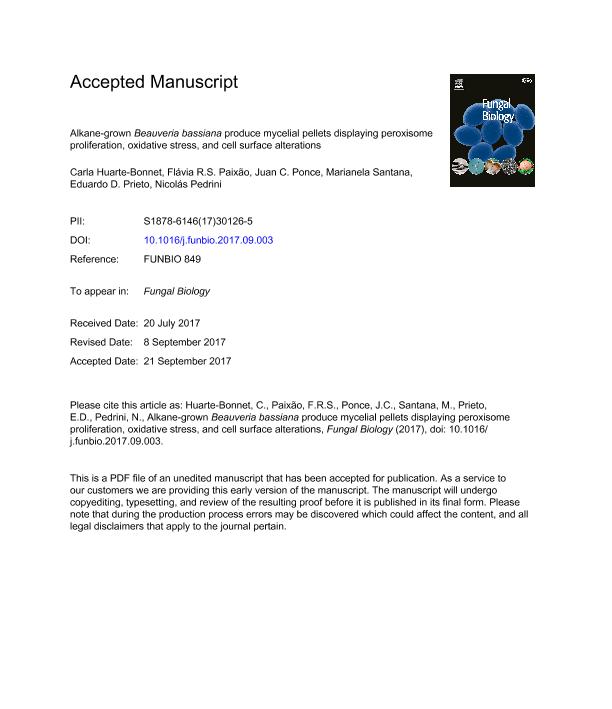Artículo
Alkane-grown Beauveria bassiana produce mycelial pellets displaying peroxisome proliferation, oxidative stress, and cell surface alterations
Huarte Bonnet, Carla ; Santos Da Paixao, Flavia Regina
; Santos Da Paixao, Flavia Regina ; Ponce, Juan C; Santana, Marianela
; Ponce, Juan C; Santana, Marianela ; Prieto, Eduardo Daniel
; Prieto, Eduardo Daniel ; Pedrini, Nicolás
; Pedrini, Nicolás
 ; Santos Da Paixao, Flavia Regina
; Santos Da Paixao, Flavia Regina ; Ponce, Juan C; Santana, Marianela
; Ponce, Juan C; Santana, Marianela ; Prieto, Eduardo Daniel
; Prieto, Eduardo Daniel ; Pedrini, Nicolás
; Pedrini, Nicolás
Fecha de publicación:
06/2018
Editorial:
Elsevier
Revista:
Fungal Biology
ISSN:
1878-6146
Idioma:
Inglés
Tipo de recurso:
Artículo publicado
Clasificación temática:
Resumen
The entomopathogenic fungus Beauveria bassiana is able to grow on insect cuticle18 hydrocarbons as the sole carbon source, inducing several enzymes involved in alkane19 assimilation and concomitantly increasing virulence against insect hosts. In this study, we20 describe some physiological and molecular processes implicated in growth, nutritional21 stress response, and cellular alterations found in alkane-grown fungi. The fungal cytology22 was investigated using light and transmission electron microscopy (TEM) while the surface23 topography was examined using atomic force microscopy (AFM). Fungal hydrophobicity24 was also measured on the cell surface. Additionally, the expression pattern of several genes25 associated with oxidative stress, peroxisome biogenesis, and hydrophobicity were analysed26 by qPCR. We found a novel type of growth in alkane-cultured B. bassiana similar to27 mycelial pellets described in other alkane-free fungi, which were able to germinate and28 produce viable conidia in media without a carbon source and to be pathogenic against29 larvae of the beetles Tenebrio molitor and Tribolium castaneum. Optical microscopy and30 TEM showed that pellets were formed by hyphae cumulates with high peroxidase activity,31 exhibiting peroxisome proliferation and an apparent surface thickening. Alkane-grown32 conidia appeared to be more hydrophobic and cell surfaces displayed different topography33 than glucose-grown cells, as it was observed by AFM. We also found a significant34 induction in several genes encoding for peroxins, catalases, superoxide dismutases, and35 hydrophobins. These results show that both morphological and metabolic changes are36 triggered in mycelial pellets derived from alkane-grown B. bassiana.
Palabras clave:
Entomopathogenic Fungi
,
Hydrocarbon Degradation
,
Hydrophobicity
,
Peroxins
Archivos asociados
Licencia
Identificadores
Colecciones
Articulos(INIBIOLP)
Articulos de INST.DE INVEST.BIOQUIMICAS DE LA PLATA
Articulos de INST.DE INVEST.BIOQUIMICAS DE LA PLATA
Articulos(INIFTA)
Articulos de INST.DE INV.FISICOQUIMICAS TEORICAS Y APLIC.
Articulos de INST.DE INV.FISICOQUIMICAS TEORICAS Y APLIC.
Citación
Huarte Bonnet, Carla; Santos Da Paixao, Flavia Regina; Ponce, Juan C; Santana, Marianela; Prieto, Eduardo Daniel; et al.; Alkane-grown Beauveria bassiana produce mycelial pellets displaying peroxisome proliferation, oxidative stress, and cell surface alterations; Elsevier; Fungal Biology; 122; 6; 6-2018; 457-464
Compartir
Altmétricas



